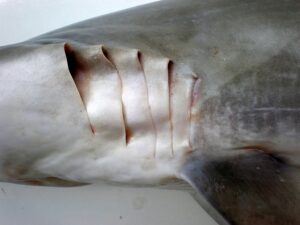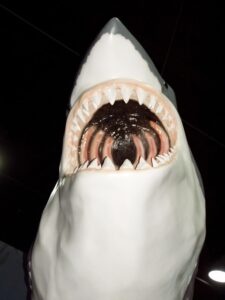Sharks are the world’s top predators. While some sharks are smaller than others, certain species are the largest.
Both basking sharks and great white sharks are massive creatures with distinct characteristics. However, these two species have several aspects that differentiate them from each other including size, look, diet, lifespan, and so on. In addition, one is bulkier and a filter feeder and the other is smaller yet voracious.
Despite the fact that both sharks species have unique traits and benefits, we will compare them in this essay. To see who comes out on top, we’ll look at numerous qualities of both of these animals.
This will be an informative post, which will give the readers some detailed information about the shark species.
Basking Shark vs. Great White Shark Comparison
Before we delve deep into comparing specific features of these sharks, here is a summarized version of some of their basic facts.
| Comparing Parameters | Basking Shark | Great White Shark |
| Scientific name | Cetorhinus maximus | Carcharodon carcharias |
| Family | Cetorhinidae | Lamnidae |
| Genus | Cetorhinus | Carcharodon |
| Teeth | Yes. Tiny. | Yes |
| Distribution | Worldwide in temperate latitudes | Saltwater |
| Weight | 10,000 lbs | 4000 lbs |
| Length | Up to 45 feet | 20 feet (approx.) |
| Swim speed | 2.5- 4 mph | 25 mph/ Short bursts of 35 mph |
| Cannibalism | Intrauterine cannibalism | Yes |
| Bite force | Do not bite. | 4000 pounds per square inch |
| Danger to humans | Harmless | Most likely |
| Lifespan | Up to 50 years | Up to 70 years |
| Conservation status | Vulnerable | Vulnerable |

Basking Shark vs. Great White Shark: Appearance
After looking at any creature, its appearance is the first thing that strikes our minds. So let’s look at the physical distinctions between a basking shark and a great white shark.
Basking sharks are enormous, and their gills may be seen clearly when viewed from the top. In addition, the coloration of these sharks is consistent. On the other hand, great whites have gills that are less visible from the top and come in two colorations.
Although the size will immediately determine whether a shark is basking or a great white, focusing on the coloration will provide further information. Furthermore, a basking shark has a unique caudal fin and an unusual-looking snout, making it easier to identify it.
Basking Shark vs. Great White Shark: Size

One of the most key distinctions between a basking shark and a great white shark is their size. You can determine the difference between these two species by their size.
The basking shark is the second-largest shark species, with a maximum length of 45 feet and a weight of 10,000 pounds, much above that of a great white. On the other hand, a great white shark may grow up to 20 feet long and weighs over 4000 pounds, making it one of the most feared shark species.
The size of basking sharks makes them stand at a higher position than great white sharks. So, in this context, basking sharks win the race.
Basking Shark vs. Great White Shark: Bite Force
Sharks often have a powerful bite force, sometimes exceeding the most ferocious land predators. Most of their bites are powerful enough to rip significant chunks of meat off their prey’s bodies.
In this aspect, great white sharks have a biting force of roughly 4000 pounds per square inch, which puts them in second place among creatures with the strongest bite force. Most interesting, however, is the fact that basking sharks do not bite, So they do not have any biting force.
Basking sharks have distinct and unusual feeding behavior. They swim with their jaws open wide to filter and ingest as many germs as possible. As a result, they do not need to bite, like great white sharks, to eat; instead, they simply swallow.
Basking Shark vs. Great White Shark: Breathing System

It is interesting to learn about how sharks breathe because they do not possess lungs. However, despite having gills, not all shakrs breathe in the same way.
To breathe, both basking and great white sharks must continue to swim. To breathe, these sharks employ ram ventilation. As a consequence, pushing ahead keeps a steady stream of oxygenated water flowing through their gills.
Hence, it is safe to assume these sharks would drown and die from suffocation if they stopped swimming. As a result, you’ll notice that these sharks are always moving, even when they’re resting.
Basking Shark vs. Great White Shark: Sleep/ Resting Habit
Sharks don’t sleep or rest in the same manner that humans do. Nonetheless, they undergo resting periods throughout the daytime.
Since both basking and great white sharks need to swim constantly, they do not rest for long at a time. On the contrary, they keep on moving and oscillate between active and inactive phases while resting.
Basking Shark vs. Great White Shark: Aggression Level
We frequently link a creature’s size with its temperament. But, in the case of basking and great white sharks, can the same be said? Let’s explore.
Basking sharks are the world’s second-largest species of sharks, however, they are not dangerous. They are also classified as endangered in certain parts of the world. However, great white sharks prefer to differ since they are quite aggressive. Humans have also been known to be attacked unprovoked by this species.
One of the most hazardous shark species is the great white shark. They’re highly curious, and they’ve remained the uncontested king of aggression with over 300 unprovoked attacks on humans.
Basking Shark vs. Great White Shark: Teeth

Sharks’ teeth are something that gives them a unique look. So whenever we think of sharks, we think of their toothy grins and widely open jaws.
Great white sharks and basking sharks both have teeth. Despite having more teeth than any other sharks on earth, basking sharks don’t really bite. Great white sharks, on the contrary, are vicious biters. They are predatory, curious, and would not hesitate to bite things simply to figure them out.
It’s worth noting in this regard that the world’s second-largest shark species has an average of 1,500 teeth. However, their teeth are quite tiny, making them appear toothless at first glance. On the contrary, a great white shark would have 300 serrated teeth plus a reserve of backup teeth in its mouth.
Basking Shark vs. Great White Shark: Jaw Length
Along with the teeth, the jaws of sharks are of great fascination. It is the ability of a shark to open its jaws wide that determines how well it can have a bite of its prey.
Basking sharks have a tremendously large mouth that can open up to 3 feet wide. However, these sharks do not open their jaws wide to bite the prey but to swallow it directly. On the other hand, great white sharks can have retractable jaws that open up to 3.93 feet.
Basking Shark vs. Great White Shark: Diet
We all know that sharks are predatory creatures. But you will find differences in their food habit. Here, we will give a closer look at the diet of basking sharks and great whites.
Despite having roughly 100 teeth per row in their mouths, basking sharks are filter feeders. Basking sharks eat zooplankton, tiny fishes, and crustaceans mostly. That being said, great white sharks are vicious predators who will consume anything they get, including turtles, sea lions, seals, and other sharks.
It is worth noting that basking sharks are among the three shark species that are particularly filter feeders. These sharks open their mouths and strain food through a filtering system to feed themselves.
It’s also important to remember that great white sharks are opportunistic feeders. It suggests they don’t have a specific prey preference and will eat any readily available prey.
Basking Shark vs. Great White Shark: Lifespan
Sharks are counted among long-living creatures on earth. But their average lifespan varies depending on their species and other external factors.
In general, it is estimated that a basking shark would live up to 50 years. However, there have been instances when scientists have found basking sharks above 50 years of age. On the other hand, great white sharks can live as long as for 70 years.
Basking Shark vs. Great White Shark: The Winner
After a thorough comparative study of both basking and great white sharks, it is time to declare the winner.
There is no winner here. We say so because basking sharks and great white sharks are completely opposite each other. They differ in almost every aspect ranging from their appearance, diet, temperament, and so on. Hence, it is safe to state that these species are unique in their own ways.
In this context, these two species do not really engage in any fight or war, so there is no winner or loser.
Summary
Before we conclude this article, we’d want to point out that both of these shark species are unique. And that they are both vulnerable because humans, whether intentionally or unwittingly, hunt them. We hope you learned something new about sharks after reading this article. If you loved it, do tell your friends about this post.




